

Species Profile | Images | Breeding Report | Similar Species
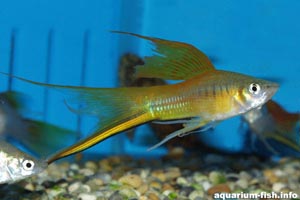
(Other members of the genus Xiphophorus)
ADULT SIZE: 11 cm
WATER CONDITIONS: Moderately hard and alkaline
TEMPERATURE RANGE: 22-28 C
FOOD: Feed Xiphophorus helleri live and dried foods. Not a fussy eater at all.
DISTRIBUTION: This species comes from Guatemala, Mexico
AQUARIUM CARE: One of the most popular aquarium fishes, and a great candidate for the beginners aquarium. The wild type swordtail, or green swordtail is very common, but it also comes in many other colour forms and shapes: typically with varying degrees of red, white, yellow and black.
This is a very tough species that can adapt to most water conditions, though preferring slightly harder water. Sexing is easy as the males have a 'sword' on their caudal fin; females are slightly larger and overall more rounded.
This is a great community species, although males can get somewhat aggressive at times, so provide ample hiding places for subdominant males females and fry.
BREEDING: A very easy livebearer that gives birth to large fry. Females can be seperated (breeding trap) when heavily pregnant to avoid unwanted male attention, and to avoid predation of the newly born fry. Even when bred in a well-stocked community tank, some fry will survive. Swordtails will interbreed with platies (Xiphophorus maculatus) if kept in the same aquarium.
Have you bred Xiphophorus helleri? Why not fill in a breeding questionaire?, or examine existing Xiphophorus helleri breeding reports
Other members of the genus Xiphophorus
Other livebearer species
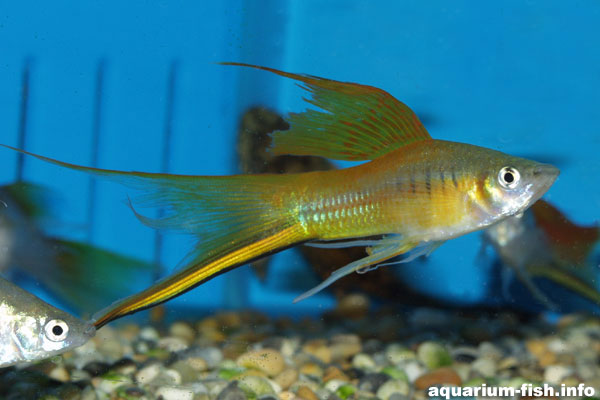
Swordtails come in different varieties - pictured is a male lyretail swordtail
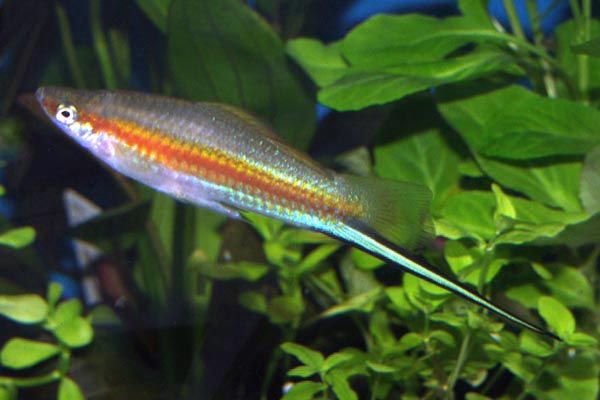
The green swordtail is the wild-type fish. Only the males having the spectacular sword extension to its tail.
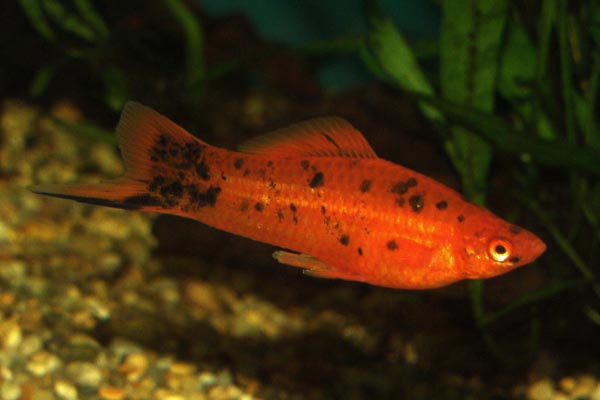
The red swordtail is a very bright orange-red colour. This young male's sword is a lot smaller than a fully-grown adult.
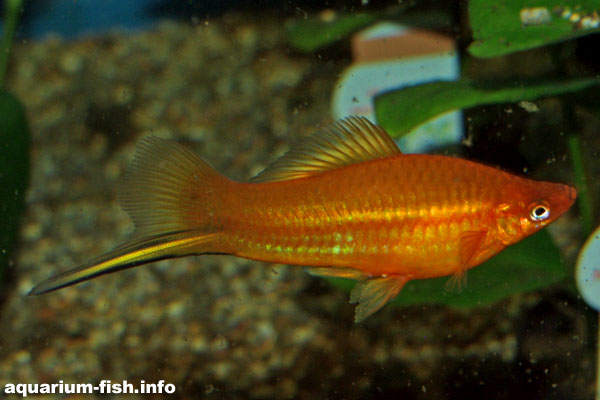
An attractive male swordtail
BREEDING: A very easy livebearer that gives birth to large fry. Females can be seperated (breeding trap) when heavily pregnant to avoid unwanted male attention, and to avoid predation of the newly born fry. Even when bred in a well-stocked community tank, some fry will survive. Swordtails will interbreed with platies (Xiphophorus maculatus) if kept in the same aquarium.
Have you bred Xiphophorus helleri? Why not fill in a breeding questionaire?
This page summarises breeding reports provided by visitors to this site, along with some statistical analysis. Please feel free to contribute - whatever your experience!
| |||||||||
|
| ||||||||
|
| ||||||||
| |||||||||
|
| ||||||||
Remember, each record represents only one persons experience; if you had different results, or used different methods, please share your experiences
| Water conditions: Moderately hard and alkaline | Water temperature: 24-27oC |
| Disposition: Somewhat aggresive on occasions | Community tank?: Yes, a good community fish |
| Spawning Method: Adult fish removed from tank | Breeding problems: none |
| Sex ratio: Almost all females | Breeding difficulty: Very easy |
| Sucess: Very sucessful | Years Experience: 2 |
| Other Comments: Have had a ratio of 85% female to 15% male. Fed on high protein pellets, black worms and vegetable flakes. unfortunately if female isn't penned and removed after birth she will eat majority of the fry. My spawning method is 1 male per 4 females. None of my males are kept together due to high aggression. Male is kept with females for only 1 month | |
| Date this record created: 5th September 2016 | Breeding date: 2016 |
| Breeder: Zoe | Location: Australia |
| Water conditions: Moderately hard and alkaline | Water temperature: 24-27oC |
| Disposition: Active, but not aggresive | Community tank?: Yes, a good community fish |
| Spawning Method: Other (see below) | Breeding problems: none |
| Sex ratio: Somewhat female heavy | Breeding difficulty: Very easy |
| Sucess: Fairly sucessful | Years Experience: 1 |
| Other Comments: | |
| Date this record created: 22nd November 2009 | Breeding date: 2009 |
| Breeder: | Location: |
| Water conditions: Moderately hard and alkaline | Water temperature: 24-27oC |
| Disposition: Somewhat aggresive on occasions | Community tank?: Only with species of similar size |
| Spawning Method: Spawning Mops | Breeding problems: none |
| Sex ratio: Somewhat male heavy | Breeding difficulty: Very easy |
| Sucess: Fairly unsucessful | Years Experience: 4 |
| Other Comments: | |
| Date this record created: 8th January 2008 | Breeding date: 2007 |
| Breeder: Ejaz | Location: |
| Water conditions: Very hard and alkaline | Water temperature: 24-27oC |
| Disposition: Active, but not aggresive | Community tank?: Yes, a good community fish |
| Spawning Method: Long term (fry appear with adults) | Breeding problems: none |
| Sex ratio: Roughly equal | Breeding difficulty: Very easy |
| Sucess: Very sucessful | Years Experience: 5 |
| Other Comments: An easy livebearer - put them in a tank, and as long as they are not housed with something that will eat the fry, you will soon have a tankful | |
| Date this record created: 6th January 2008 | Breeding date: 1995 |
| Breeder: | Location: |